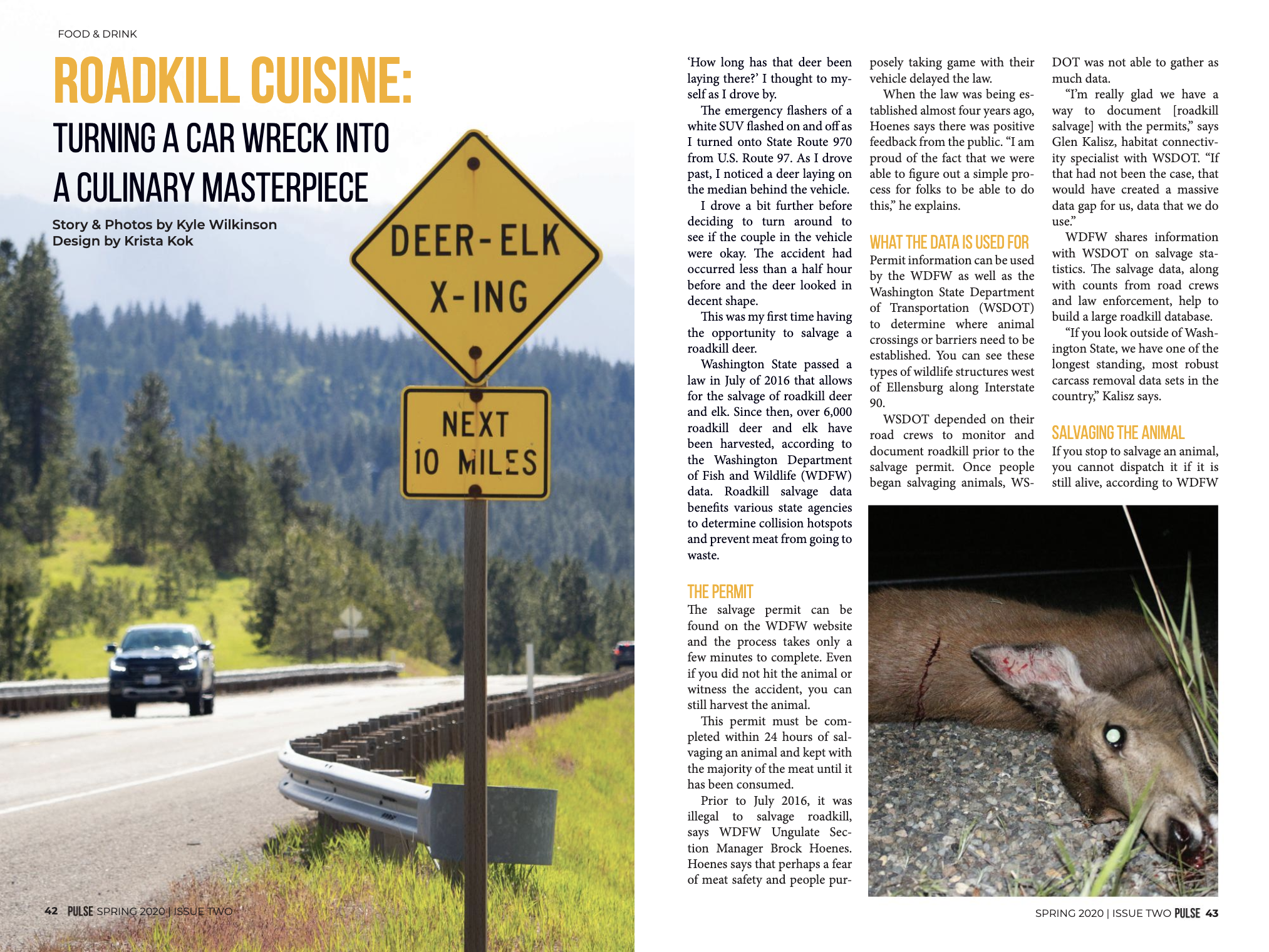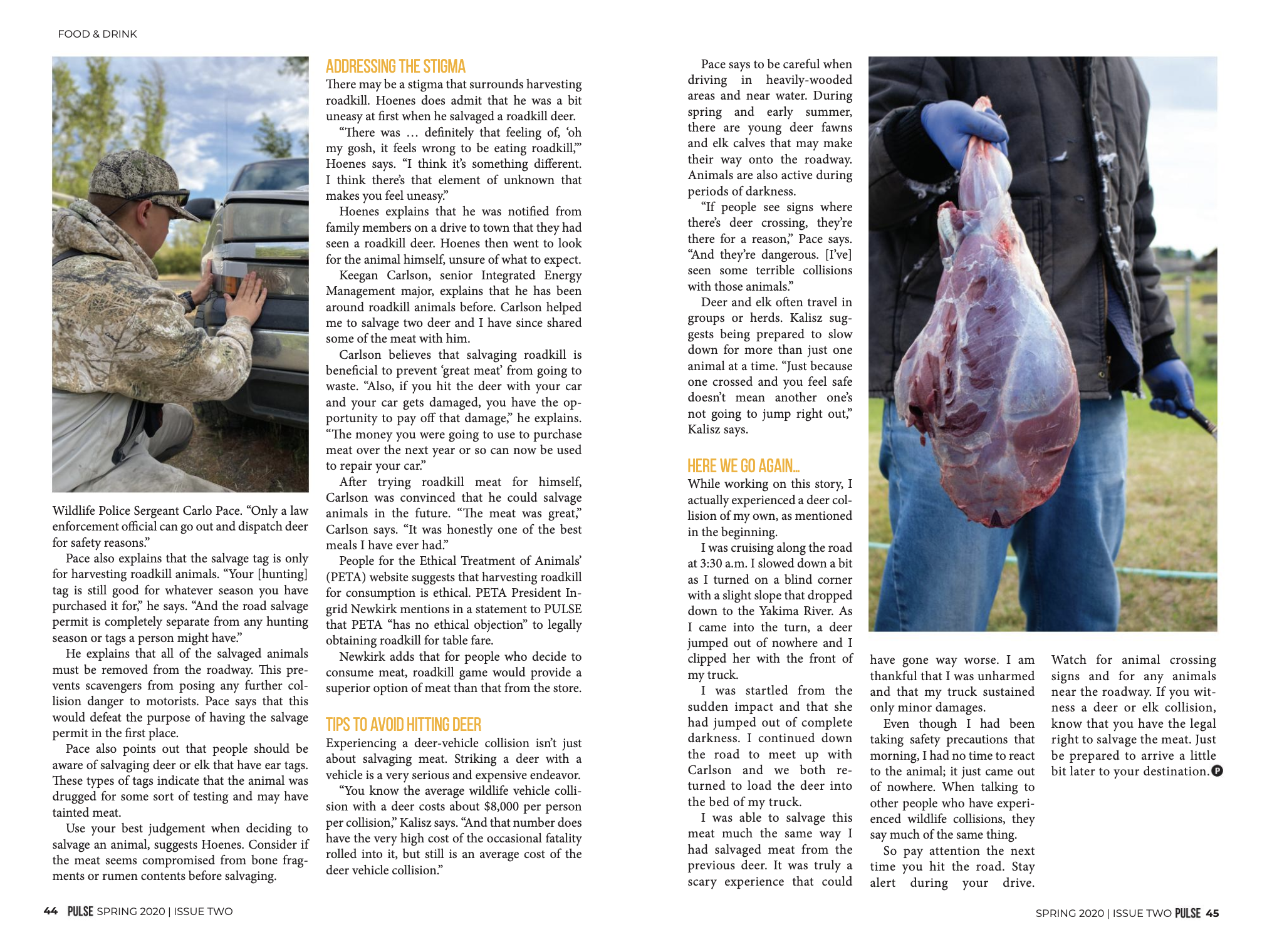Roadkill Cuisine: Turning a Car Wreck Into a Culinary Masterpiece
Story and Photos by Kyle Wilkinson | Design by Krista Kok
‘How long has that deer been laying there?’ I thought to myself as I drove by.
The emergency flashers of a white SUV flashed on and off as I turned onto State Route 970 from U.S. Route 97. As I drove past, I noticed a deer laying on the median behind the vehicle.
I drove a bit further before deciding to turn around to see if the couple in the vehicle were okay. The accident had occurred less than a half hour before and the deer looked in decent shape.
This was my first time having the opportunity to salvage a roadkill deer.
Washington State passed a law in July of 2016 that allows for the salvage of roadkill deer and elk. Since then, over 6,000 roadkill deer and elk have been harvested, according to the Washington Department of Fish and Wildlife (WDFW) data. Roadkill salvage data benefits various state agencies to determine collision hotspots and prevent meat from going to waste.
The Permit
The salvage permit can be found on the WDFW website and the process takes only a few minutes to complete. Even if you did not hit the animal or witness the accident, you can still harvest the animal.
This permit must be completed within 24 hours of salvaging an animal and kept with the majority of the meat until it has been consumed.
Prior to July 2016, it was illegal to salvage roadkill, says WDFW Ungulate Section Manager Brock Hoenes. Hoenes says that perhaps a fear of meat safety and people purposely taking game with their vehicle delayed the law.
When the law was being established almost four years ago, Hoenes says there was positive feedback from the public. “I am proud of the fact that we were able to figure out a simple process for folks to be able to do this,” he explains.
What the Data is Used For
Permit information can be used by the WDFW as well as the Washington State Department of Transportation (WSDOT) to determine where animal crossings or barriers need to be established. You can see these types of wildlife structures west of Ellensburg along Interstate 90.
WSDOT depended on their road crews to monitor and document roadkill prior to the salvage permit. Once people began salvaging animals, WSDOT was not able to gather as much data.
“I’m really glad we have a way to document [roadkill salvage] with the permits,” says Glen Kalisz, habitat connectivity specialist with WSDOT. “If that had not been the case, that would have created a massive data gap for us, data that we do use.”
WDFW shares information with WSDOT on salvage statistics. The salvage data, along with counts from road crews and law enforcement, help to build a large roadkill database.
“If you look outside of Washington State, we have one of the longest standing, most robust carcass removal data sets in the country,” Kalisz says.
Salvaging the Animal
If you stop to salvage an animal, you cannot dispatch it if it is still alive, according to WDFW Wildlife Police Sergeant Carlo Pace. “Only a law enforcement official can go out and dispatch deer for safety reasons.”
Pace also explains that the salvage tag is only for harvesting roadkill animals. “Your [hunting] tag is still good for whatever season you have purchased it for,” he says. “And the road salvage permit is completely separate from any hunting season or tags a person might have.”
He explains that all of the salvaged animals must be removed from the roadway. This prevents scavengers from posing any further collision danger to motorists. Pace says that this would defeat the purpose of having the salvage permit in the first place.
Pace also points out that people should be aware of salvaging deer or elk that have ear tags. These types of tags indicate that the animal was drugged for some sort of testing and may have tainted meat.
Use your best judgement when deciding to salvage an animal, suggests Hoenes. Consider if the meat seems compromised from bone fragments or rumen contents before salvaging.
Addressing the Stigma
There may be a stigma that surrounds harvesting roadkill. Hoenes does admit that he was a bit uneasy at first when he salvaged a roadkill deer.
“There was … definitely that feeling of, ‘oh my gosh, it feels wrong to be eating roadkill,’” Hoenes says. “I think it’s something different. I think there’s that element of unknown that makes you feel uneasy.”
Hoenes explains that he was notified from family members on a drive to town that they had seen a roadkill deer. Hoenes then went to look for the animal himself, unsure of what to expect.
Keegan Carlson, senior Integrated Energy Management major, explains that he has been around roadkill animals before. Carlson helped me to salvage two deer and I have since shared some of the meat with him.
Carlson believes that salvaging roadkill is beneficial to prevent ‘great meat’ from going to waste. “Also, if you hit the deer with your car and your car gets damaged, you have the opportunity to pay off that damage,” he explains. “The money you were going to use to purchase meat over the next year or so can now be used to repair your car.”
After trying roadkill meat for himself, Carlson was convinced that he could salvage animals in the future. “The meat was great,” Carlson says. “It was honestly one of the best meals I have ever had.”
People for the Ethical Treatment of Animals’ (PETA) website suggests that harvesting roadkill for consumption is ethical. PETA President Ingrid Newkirk mentions in a statement to PULSE that PETA “has no ethical objection” to legally obtaining roadkill for table fare.
Newkirk adds that for people who decide to consume meat, roadkill game would provide a superior option of meat than that from the store.
Tips to Avoid Hitting Deer
Experiencing a deer-vehicle collision isn’t just about salvaging meat. Striking a deer with a vehicle is a very serious and expensive endeavor.
“You know the average wildlife vehicle collision with a deer costs about $8,000 per person per collision,” Kalisz says. “And that number does have the very high cost of the occasional fatality rolled into it, but still is an average cost of the deer vehicle collision.”
Pace says to be careful when driving in heavily-wooded areas and near water. During spring and early summer, there are young deer fawns and elk calves that may make their way onto the roadway. Animals are also active during periods of darkness.
“If people see signs where there’s deer crossing, they’re there for a reason,” Pace says. “And they’re dangerous. [I’ve] seen some terrible collisions with those animals.”
Deer and elk often travel in groups or herds. Kalisz suggests being prepared to slow down for more than just one animal at a time. “Just because one crossed and you feel safe doesn’t mean another one’s not going to jump right out,” Kalisz says.
Here We Go Again…
While working on this story, I actually experienced a deer collision of my own, as mentioned in the beginning.
I was cruising along the road at 3:30 a.m. I slowed down a bit as I turned on a blind corner with a slight slope that dropped down to the Yakima River. As I came into the turn, a deer jumped out of nowhere and I clipped her with the front of my truck.
I was startled from the sudden impact and that she had jumped out of complete darkness. I continued down the road to meet up with Carlson and we both returned to load the deer into the bed of my truck.
I was able to salvage this meat much the same way I had salvaged meat from the previous deer. It was truly a scary experience that could have gone way worse. I am thankful that I was unharmed and that my truck sustained only minor damages.
Even though I had been taking safety precautions that morning, I had no time to react to the animal; it just came out of nowhere. When talking to other people who have experienced wildlife collisions, they say much of the same thing.
So pay attention the next time you hit the road. Stay alert during your drive. Watch for animal crossing signs and for any animals near the roadway. If you witness a deer or elk collision, know that you have the legal right to salvage the meat.
Just be prepared to arrive a little bit later to your destination.










